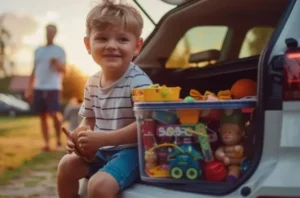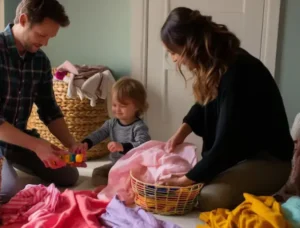Family-First Moving: A Practical Checklist for Parents with Children
Moving with kids doesn’t have to be chaotic. This parent-friendly guide from Professional Torrance Movers gives you a clear, actionable checklist—what to do, when to do it, and how to keep routines stable—so your family arrives calm, prepared, and ready to settle in.

6–8 Weeks Out: Set the Foundation
-
Talk early and honestly: explain why you’re moving, when it’s happening, and what will stay the same (family routines, favorite items). Invite questions and feelings.
-
Choose timing with kids in mind: if possible, align around school calendars, sports seasons, and caregiving schedules to reduce disruption.
-
Research the new area together: shortlist schools, childcare, parks, libraries, after‑school options, pediatricians, dentists, and urgent care near your new address.
-
Start school transfer steps: request records, immunization forms, and IEP/504 files where applicable; note enrollment deadlines and required documents.
-
Create a family moving calendar: block packing milestones, farewell plans, appointments, and important school dates; add buffer days for the unexpected.
4–5 Weeks Out: Organize and Declutter
-
Declutter by category with kid input: keep, donate, sell, or pass‑along; let children choose a few “must‑keep” items for control and comfort.
-
Sort outgrown items: donate clothing, toys, books, and sports gear; note any sentimental items to preserve or scan.
-
Order packing supplies: small/medium boxes, wardrobe boxes, heavy‑duty tape, labels, bubble wrap, packing paper, zip bags, and clear bins for kids’ essentials.
-
Create “Do Not Pack” zones: documents, medications, devices/chargers, comfort toys, bedtime items, and school essentials stay separate and accessible.
2–3 Weeks Out: Prep Rooms and Routines
-
Pack low‑use areas first: seasonal clothes, décor, extra toys, and books; keep daily‑use items out until the final days.
-
Color‑code labels by room: include child’s name, room, and priority (Open First, Week One, Later). Number boxes and keep a simple inventory.
-
Photograph setups: kids’ room shelves, gaming/TV wiring, and study spaces to re‑create quickly in the new home.
-
Confirm childcare or helpers: line up sitters, grandparents, or a trusted friend for packing days and moving day.
The Week Before: Comfort and Continuity
-
Build each child’s “First‑Night” kit: pajamas, favorite plush/blanket, two outfits, toiletries, bedtime book, nightlight, snacks, water bottle, and school items.
-
Pack a family “Go Bag”: medications, thermometers, basic first aid, wipes, sanitizer, chargers, portable battery, documents, and small cash.
-
Keep routines steady: meal and sleep schedules anchor kids; plan simple, familiar dinners and protected downtime.
-
Plan goodbyes: quick class announcements, playdate, photo album of friends/places, and a keepsake signature page or T‑shirt.
Moving Day: Safety and Smooth Flow
-
Arrange supervision: if possible, have young kids off‑site; otherwise, set up a “safe room” with snacks, crafts, and a helper to supervise.
-
Stage the home: clear paths, protect floors, prop doors safely, and cluster room‑labeled boxes near exits.
-
Prioritize kids’ rooms at destination: ask the crew to unload and place children’s beds and boxes first; make beds before evening.
-
Keep the Go Bag with you: do not load medications, documents, or comfort items on the truck.
Travel Logistics with Kids
-
Car travel: schedule frequent breaks, pack a cooler, rotate activities, preload audiobooks and playlists, and confirm car seats meet safety guidelines.
-
Air travel: carry extra outfits, snacks, empty water bottles, wipes, headphones, and comfort items in a personal backpack per child; pre‑download entertainment.


First 48 Hours: Fast Comfort Wins
-
Set up sleep first: beds, nightlights, curtains/blinds, white‑noise device or fan, and the bedtime routine.
-
Create a familiar corner: favorite books, stuffed animals, a small rug, and a few framed photos to signal “home.”
-
Rebuild the study spot: desk, lamp, supplies, device chargers, and a designated homework bin.
-
Tour the neighborhood: park, school route, library, and a nearby café or ice cream shop to anchor positive associations.
School and Activity Transitions
-
Confirm enrollment: double‑check start dates, bus routes, after‑care, and required forms; schedule school tours if available.
-
Transfer activities: notify coaches and instructors; look for trial classes in the new area to re‑establish routine quickly.
-
Social bridges: set up intro playdates via school/parent groups; help kids practice a simple self‑intro and share interests.
Emotional Check‑Ins and Support
-
Daily check‑ins: a quick “rose/bud/thorn” chat (best thing, what’s ahead, toughest part) helps kids process the change.
-
Memory projects: a photo book of the old home and a “new home wish list” give closure and excitement.
-
Watch for stress signals: sleep changes, clinginess, or school resistance; respond with extra routine, reassurance, and small choices kids can control.
Special Notes by Age
-
Toddlers/Preschool: keep nap/bedtime consistent; transition one change at a time; use picture books about moving.
-
Elementary: involve them in labeling and room planning; give choices on décor and the first‑week activity.
-
Tweens/Teens: include them in scheduling, school selection research, and budget‑aware room setup; respect privacy and friend time.
Quick Parent Checklists
-
Documents: IDs, birth certificates, immunizations, school records, IEP/504 plans, medical/dental records, prescriptions.
-
Safety: childproof kit (outlet covers, cabinet locks), temporary baby gates, basic tools, and flashlight.
-
Essentials: medications, thermometers, comfort items, snacks, water bottles, device chargers, and a compact first‑aid kit.
-
Home setup: beds and bedding, towels, shower curtain/liners, basic cookware, paper goods, soap, trash bags, and a multi‑tool.
How Professional Torrance Movers Can Help
-
Family‑smart scheduling: preferred unload order with children’s rooms first.
-
Packing and setup: kitchen and kids’ room priority services, debris removal, and furniture reassembly.
-
Gentle handling: labeled, kid‑room‑specific staging to speed up first‑night comfort and next‑day school readiness.







